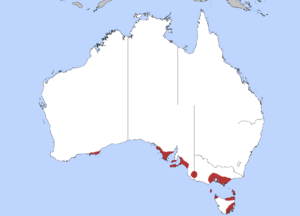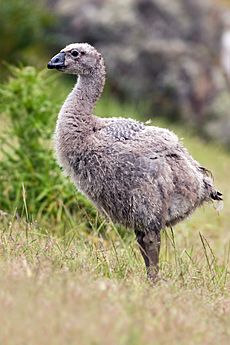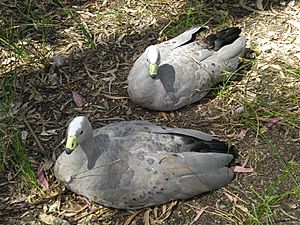Cape Barren goose facts for kids
The Cape Barren goose (scientific name: Cereopsis novaehollandiae) is a big goose that lives in southern Australia. It got its name from Cape Barren Island, which is where European explorers first saw these birds.
Quick facts for kids Cape Barren goose |
|
|---|---|
 |
|
| Conservation status | |
| Scientific classification | |
| Genus: |
Cereopsis
|
| Species: |
novaehollandiae
|
| Subspecies | |
|
C. n. novaehollandiae Latham, 1801 |
|
 |
|
| Distribution of the Cape Barren goose | |
About Its Name
The Cape Barren goose was first described by an English bird expert, John Latham, in 1801. He gave it its scientific name.
This goose is quite unique. Scientists are still figuring out its exact family tree. It might be a "true goose" or related to shelducks. Some even think it belongs in its own special group.
There's a smaller group of Cape Barren geese in Western Australia. These are a different type, called a subspecies. Their scientific name is Cereopsis novaehollandiae grisea. They are named after the Recherche Archipelago islands.
What It Looks Like

These geese are quite large and heavy. Their feathers are mostly grey. They have round black spots on their bodies. Their tail and flight feathers are black. Their legs are pink, and their feet are black.
The goose has a short, curved black beak. It also has a bright green area on its beak called a cere. This gives it a very distinct look.
A Cape Barren goose is usually about 75 to 100 centimeters (30 to 39 inches) long. It weighs between 3 and 7 kilograms (7 to 15 pounds). Its wings can spread out from 150 to 190 centimeters (59 to 75 inches) wide. Male geese are a bit bigger than females. This bird mostly eats grass and rarely swims.
How It Behaves
Cape Barren geese can drink salty water. This means many of them can stay on islands off the coast all year. They are one of the rarest types of geese in the world.
When it's not breeding season, they like to be in groups. They travel around more and form small flocks.
Where It Lives
The number of these geese had gone down before. But now, it seems their numbers are growing again. This is because geese in the eastern parts of Australia have learned to eat crops on farms.
They build their nests on the ground in groups. These nesting areas are usually on grassy islands off the Australian coast. These geese can also live well in zoos or special parks. They will even breed if they have enough space.
In the 1800s, explorers in Australia named many islands "Goose Island." They did this because they saw so many Cape Barren geese there.
A small group of these geese was brought to Christchurch, New Zealand. They have continued to live there since then. In 1968, some geese were also brought to Maria Island in Australia.
See also
 In Spanish: Ganso ceniciento para niños
In Spanish: Ganso ceniciento para niños






